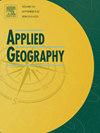The impact of changes in land transfer decisions on rural livelihood transitions: Evidence from dynamic panel data in China
IF 4
2区 地球科学
Q1 GEOGRAPHY
引用次数: 0
Abstract
Both the land transfer and livelihood transition decisions of rural households are continuously evolving and closely interconnected, particularly within the context of the ongoing rural-urban divide and agricultural modernization. Existing research, however, fails to capture the dynamics in land transfer decisions and their impacts on rural household livelihood transitions, often overlooking the endogeneity of causality. To address this gap, this study utilizes a nationally representative panel dataset of 2276 rural households to delineate households' livelihood strategies through k-means clustering and analyze the characteristics, trends in livelihood transition, and shifts in land transfer decisions among these households from 2010 to 2020. By employing panel instrumental variable methods to mitigate endogeneity effects, we investigate the effects of changes in land transfer decisions on livelihood transitions in China and examine the moderating role of social networks. The results suggest a shift in rural households' livelihood strategies from predominantly agricultural focused to a more diversified approach encompassing both agricultural and non-agricultural pursuits. There has been a growth trend in land transfer decisions, with a higher prevalence of land out-transfer compared to land in-transfer. Notably, changes in land transfer decisions exert a significant negative impact on households’ livelihood transitions (β = −0.3699, P < 0.05). Furthermore, social networks play a significant role in moderating the effects of land transfer decisions on livelihood transitions. The direction and magnitude of the impact vary depending on the differentiation in village social network structure, geomorphologic characteristics, and the presence of ecological conservation zones. These findings underscore the importance of regulating land transfer as a pivotal element of policymaking to promote sustainable rural development and enhance rural household livelihoods.
求助全文
约1分钟内获得全文
求助全文
来源期刊

Applied Geography
GEOGRAPHY-
CiteScore
8.00
自引率
2.00%
发文量
134
期刊介绍:
Applied Geography is a journal devoted to the publication of research which utilizes geographic approaches (human, physical, nature-society and GIScience) to resolve human problems that have a spatial dimension. These problems may be related to the assessment, management and allocation of the world physical and/or human resources. The underlying rationale of the journal is that only through a clear understanding of the relevant societal, physical, and coupled natural-humans systems can we resolve such problems. Papers are invited on any theme involving the application of geographical theory and methodology in the resolution of human problems.
 求助内容:
求助内容: 应助结果提醒方式:
应助结果提醒方式:


